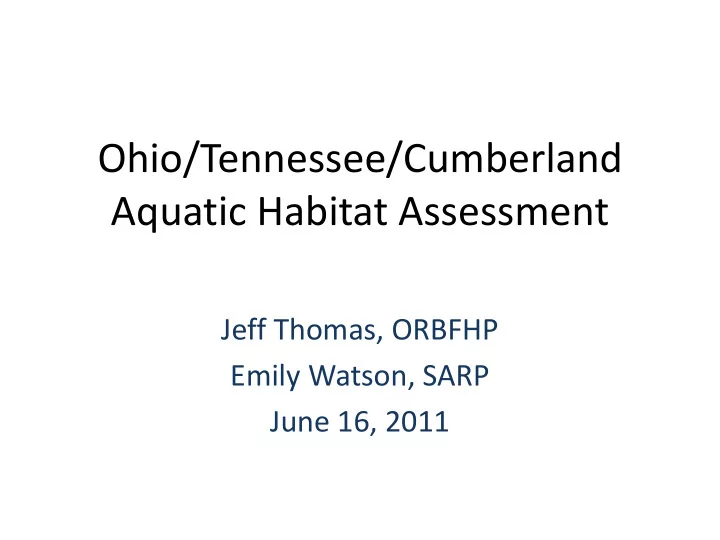

Ohio/Tennessee/Cumberland Aquatic Habitat Assessment Jeff Thomas, ORBFHP Emily Watson, SARP June 16, 2011
Background • Exploring option to run TN/Cumberland and Ohio River basin models together – Save time and effort, increased expertise, greater scope for end product • Do we loose model strength with broader geographic region? • Does it make sense biologically to combine river basins?
Quick and Dirty Model INPUT OUTPUT Landscape Predictor Data Model Results o Natural and Anthropogenic o Response variable predictions @ o Local vs. US Network vs. DS 1:100K SLW scale Network vs. Regional o Predictor variable importance weightings BOOSTED Stream or Lake Response Data o Stressor-Response functions REGRESSION o Environmental Data o Estimates of model uncertainty TREES o Fish Data • Assemblage Post-Modeling Results • Abundance o Cumulative Natural Habitat • Presence-Absence Quality Index (CHQI) • Index of Biotic Integrity o Cumulative Anthropogenic • Community Metrics Stressor Index (CASI) o CHQI and CASI accumulated from 1:100K SLW up to HUC12.
Modified Index of Centers of Diversity Scores sites based on highest abundance of rarest species • relative to all sites in the basin Model results can predict locations of biodiversity and tell • you the best sites for restoration/protection if you are interested in biodiversity density of a species ata site Relative Density sum of densities of the same species at all sites sum of the relative densities for all species at a site MICD * 10,000 total number of species fromall sites
Relative Influence of Predictor Variables
SARP only model Vs. Combined model Suggests that the combined model consistently provides lower MICD estimates among SARP catchments compared to SARP only model Note: on the log scale
SARP model’s ability to predict Suggests that the SARP model is doing a decent job of estimating MICD in SARP, and has less bias (low or high) than the combined model
Impacts of separating • How? – Ecoregion – Political boundaries • Are they regionally meaningful?
Freshwater Ecoregions
Omernick’s Level III Ecoregions
Omernik’s Level II Ecoregions
Bailey’s Ecoregions
MICD Refinement Avg MICD Avg # Species (# Events) Stream Order OH ORB TN/CU 1 6.9 6.6 (1205) 7.6 (158) 2 10.7 12.2 (1738) 8.6 (266) 3 17 15.2 (1528) 12.8 (326) 4 19.1 21 (821) 15.7 (150) 5 32.2 22 (351) 21.7 (46) 6 37.1 19.5 (266) 18.3 (8) 7 24 18.2 (140) 31 (1) 8 15 18 (404) 9 14.4 16.8 (64)
MICD Refinement • Use only 3-6 orders? Stream Order Max MICD 1 433 • Score as a % of max/order 2 484 3 700 4 630 5 805 6 487 7 303 8 394 9 373
Recommend
More recommend